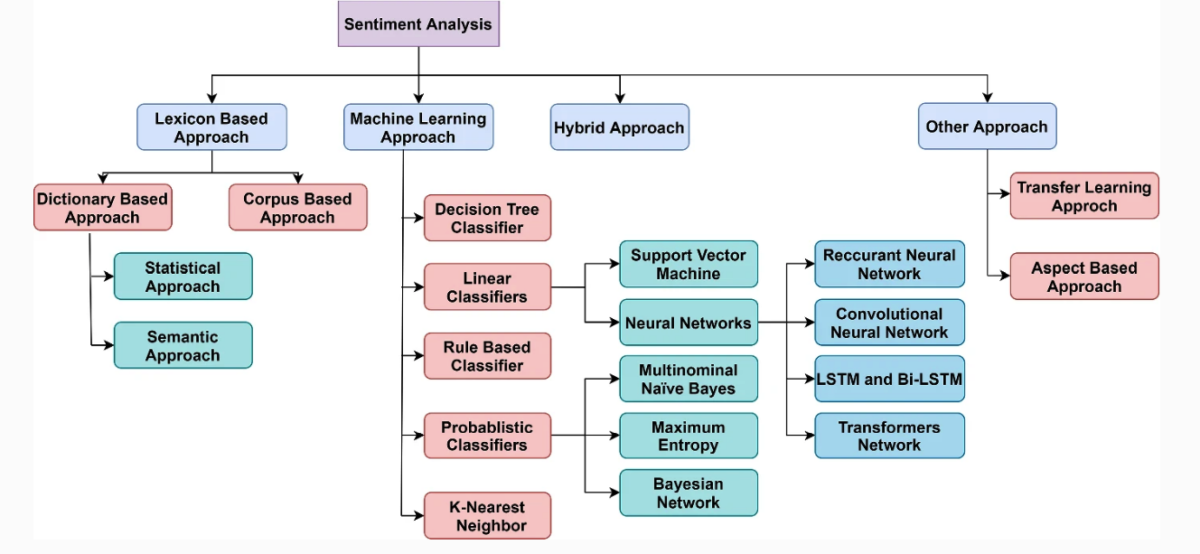Sentiment analysis, a revolutionary field in data analysis, delves into the complex world of human emotions and opinions. In this article, we will explore the various sentiment analysis methods, ranging from traditional approaches to cutting-edge technologies, and examine their applications across different industries.
Sentiment Analysis Methods

Understanding the sentiments expressed in data has become crucial in this age of information overload. Sentiment analysis, also known as opinion mining, involves deciphering emotions and opinions embedded in textual content. From social media posts to customer reviews, sentiment analysis provides invaluable insights into public perception.
Traditional Methods
1. Rule-based Approaches
One of the earliest methods in sentiment analysis involves creating rules to identify sentiments based on predefined criteria. This method relies on linguistic rules and patterns to determine the sentiment behind a piece of text.
2. Lexicon-based Methods
Lexicon-based methods utilize dictionaries or lexicons containing words associated with specific sentiments. The presence and frequency of these words in a text help determine its overall sentiment.
Machine Learning Techniques
1. Supervised Learning for Sentiment Analysis
Supervised learning employs labeled datasets to train models in identifying sentiments accurately. This method involves categorizing texts into positive, negative, or neutral sentiments.
2. Unsupervised Learning and Clustering
Unsupervised learning techniques, such as clustering, involve grouping similar texts based on their inherent sentiments. This method is particularly useful when dealing with large datasets.
3. Deep Learning and Neural Networks
With advancements in technology, deep learning, and neural networks have become powerful tools in sentiment analysis. These methods can capture intricate patterns and nuances in language, enhancing the accuracy of sentiment identification.
Natural Language Processing (NLP)
NLP plays a pivotal role in sentiment analysis, enabling machines to understand and interpret human language. The continuous development of NLP algorithms has significantly improved the precision of sentiment analysis.
1. Challenges and Advancements in NLP
Despite its advancements, NLP faces challenges such as context understanding and sarcasm detection. Ongoing research aims to overcome these hurdles and further refine sentiment analysis.
Social Media Sentiment Analysis
Social media platforms serve as treasure troves of opinions and emotions. Analyzing sentiments on platforms like Twitter and Facebook provides valuable insights into public reactions, making it an essential aspect of sentiment analysis.
1. The Impact of Social Media on Sentiment Analysis
The dynamic nature of social media amplifies the impact of sentiment analysis, influencing trends, public perception, and even stock markets. Understanding and harnessing social media sentiments have become imperative for businesses and policymakers.
Challenges and Ethical Considerations
While sentiment analysis offers valuable insights, it is not without challenges. Ethical considerations, biases in data, and privacy concerns necessitate a careful approach to ensure responsible and unbiased analysis.
1. Addressing Challenges in Sentiment Analysis
Researchers and practitioners are actively working on addressing challenges, with a focus on transparency, fairness, and accountability in sentiment analysis practices.
2. Ensuring Ethical Practices in Sentiment Analysis
Implementing ethical guidelines and incorporating diverse datasets are crucial steps in ensuring the ethical practice of sentiment analysis.
Future Trends
The future of sentiment analysis holds exciting prospects, with emerging technologies poised to redefine the landscape. From sentiment-aware chatbots to emotion-aware content, the possibilities are vast.
1. Emerging Technologies in Sentiment Analysis
Advancements in machine learning, natural language processing, and artificial intelligence are paving the way for more sophisticated sentiment analysis tools.
2. The Evolving Landscape of Sentiment Analysis
As technology evolves, sentiment analysis will likely extend beyond text to include other modalities, such as audio and visual inputs, providing a more comprehensive understanding of sentiments.
Applications in Different Industries
Sentiment analysis finds applications in various industries, each benefiting from insights into customer emotions and opinions.
1. Healthcare
Understanding patient sentiments aids in improving healthcare services, patient satisfaction, and overall well-being.
2. Finance
Sentiment analysis in the financial sector helps predict market trends, assess investment risks, and understand investor sentiments.
3. Marketing
Marketers utilize sentiment analysis to gauge the effectiveness of campaigns, understand customer preferences, and tailor marketing strategies accordingly.
4. Customer Service
Businesses enhance customer service by analyzing sentiments expressed in customer feedback, enabling them to address issues promptly and improve overall satisfaction.
Sentiment Analysis Tools
Various tools facilitate sentiment analysis, offering features to streamline the process and extract meaningful insights.
1. Popular Tools for Sentiment Analysis
Tools like VADER, TextBlob, and AIM Insights are widely used for their accuracy and efficiency in sentiment analysis.
2. Features and Functionalities
These tools often include features such as sentiment polarity detection, emotion analysis, and customizable settings to meet specific analysis requirements.
DIY Sentiment Analysis
For those interested in a hands-on approach, performing sentiment analysis manually allows for a deeper understanding of the process.
Steps to Perform Sentiment Analysis Manually
- Collect relevant data
- Preprocess the text
- Assign sentiment labels
- Analyze patterns and trends
- Draw conclusions
Tips for Accurate Analysis
Consider the context, be aware of biases, and continuously refine the analysis process for more accurate results.
Impact on Decision-Making
Sentiment analysis plays a pivotal role in influencing decision-making processes across various domains.
1. How Sentiment Analysis Influences Decision-Making
From product development to policy-making, sentiment analysis guides decisions by providing insights into public opinions and preferences.
Sentiment Analysis and SEO
The intersection of sentiment analysis and search engine optimization (SEO) has gained prominence in digital marketing strategies.
1. Incorporating Sentiment Analysis in SEO Strategies
Understanding user sentiments helps tailor content, keywords, and marketing strategies to align with the emotional tone of the target audience.
2. Enhancing Content Based on Sentiments
Crafting content that resonates with the sentiments of the audience contributes to better engagement and improved SEO rankings.
User Reviews and Sentiment
User reviews significantly impact sentiment analysis, offering a wealth of opinions that can shape perceptions.
1. The Influence of User Reviews on Sentiment Analysis
Businesses can leverage user reviews to understand customer experiences, address concerns, and enhance their products or services.
2. Strategies for Managing and Leveraging Reviews
Responding to reviews, incorporating feedback, and actively managing online reputation contribute to positive sentiment analysis outcomes.
Conclusion
In conclusion, sentiment analysis is an indispensable tool for understanding and decoding human emotions in the vast digital landscape. From traditional methods to futuristic technologies, the evolution of sentiment analysis continues to shape the way we perceive and respond to information.
Ready to explore the power of sentiment analysis in your business? Request a demo from AIM Technologies today!
FAQs
Is sentiment analysis limited to text data?
- Sentiment analysis has traditionally focused on text data, but advancements are extending it to other modalities like audio and visual inputs.
How accurate are machine learning-based sentiment analysis methods?
- Machine learning-based methods, when trained on diverse datasets, can achieve high accuracy in sentiment analysis.
Are there ethical considerations in sentiment analysis?
- Yes, ethical considerations include biases in data, privacy concerns, and the responsible use of sentiment analysis in various applications.
Can sentiment analysis be applied to historical data?
- Sentiment analysis can be applied retrospectively to historical data, providing insights into past trends and sentiments.
What role does sentiment analysis play in SEO?
- Sentiment analysis in SEO helps tailor content and marketing strategies to align with the emotional tone of the target audience, enhancing engagement and search rankings.


